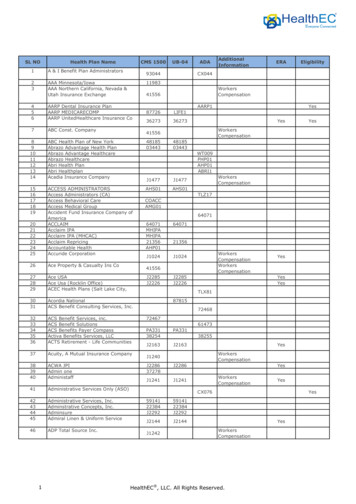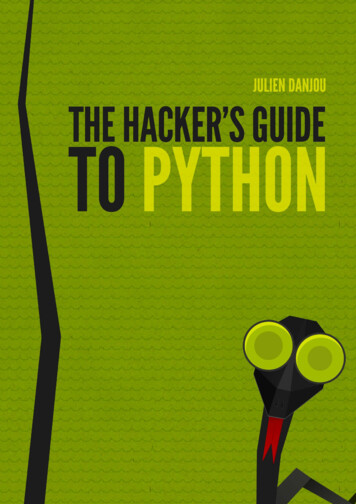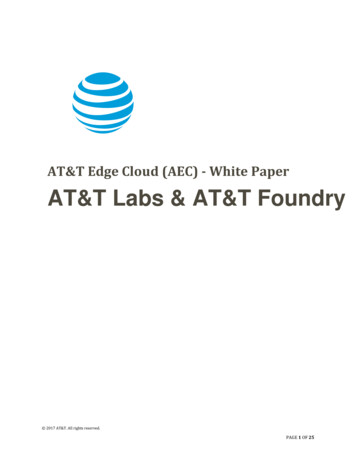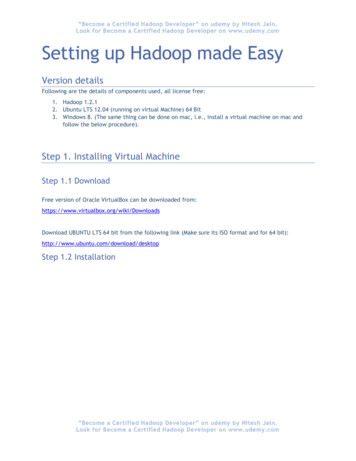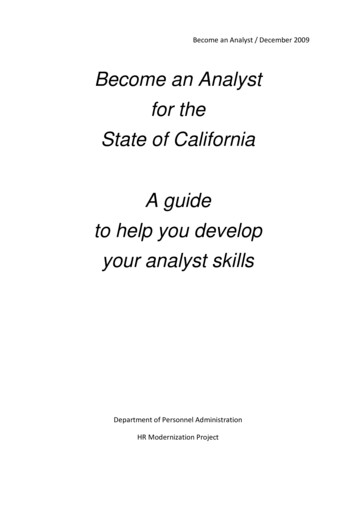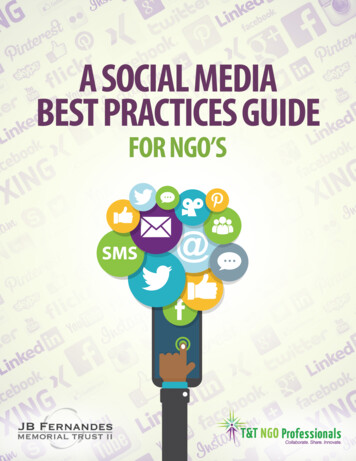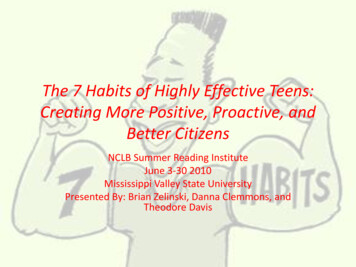
Transcription
Becoming a better politicianPolitical skills manual
Becoming a better politicianPolitical skills manualAlfred Mozer StichtingInternational Foundation for Social Democracy
IntroductionThe politician’s trade is something best learnt in practice: that is the prevailing consensus in many political parties. Of course it is true that there is no school like the schoolof hard knocks, but that is no reason to throw aspiring politicians to the wolves withoutany preparation whatsoever. Political skills can definitely be learned. The extent towhich political parties invest in this, however, varies greatly. In my opinion, a party’sprofessionalism is directly related to the amount of attention devoted to training theseskills. There is no excuse for poor preparation. The politician’s trade, like any othertrade, requires constant training.The Alfred Mozer Stichting, the international foundation for the support of social democracy, has twenty years experience in the training and schooling of political parties,youth and women groups and individual politicians. Our dedicated volunteer trainersare skilled political professionals with a broad experience in – mainly Dutch – politics.We owe a large debt of gratitude to this pool of almost 80 AMS trainers, and in thisintroduction we would like to single out Berend Jan van de Boomen, the former AMSdirector and author of our previous manual, for special mention. He wrote a number ofnew chapters and we used parts of the old manual for this brand new version. We arevery grateful for all the work he has put in.This book gives parties and politicians one excuse less for performing poorly! We attempt to give as full a treatment as possible of the skills every politician should have.Unfortunately it is impossible to be complete. In addition to which, exactly which ofthe skills mentioned are required depends largely on the (political) context and traditions in different countries. That is why this manual offers universal ingredients for a delicious political meal – but it is up to you to decide which of these ingredients apply toyour specific situation. There is no single blueprint, every situation is unique. Moreover,we cannot rule out the possibility that there are still ingredients that we have not heardof, or methods and techniques that are not being used in the political arena yet, butwill be in the near future. But we do aim to provide a book that has something to offerfor everyone. Whether you are launching a multimillion dollar campaign or workingwith the lowest of budgets, the tips in this book will ensure that everyone stands achance. Good luck! 2009 Alfred Mozer Stichtingwww.alfredmozerstichting.nlPostbus 13101000 BH AmsterdamThe NetherlandsAuthor & editor: Arjen Berkvensco-author: Berend Jan van den BoomenTranslation: Frank LeekensDesign: Laurant & BakkerArjen Berkvens, AMS director2Becoming a better politicianPolitical skills manual3
Content123456789101112131415161718194Becoming a better politicianStrategyResearchCommunications and mediaSpeaking in publicDebatingOrganisationCampaign planParty and campaign fundingVolunteersMaterials and eventsCanvassingPolicy developmentMeetingsNegotiatingForming a coalitionLobbyingThe art of political oppositionFighting your political opponentsPolitical crisis managementPolitical skills 5
Chapter 1Strategy1Lofty aims and ideals are commendable and necessary, but in the end what mattersare the results you achieve. Politics is all about preparing and implementing strategies to achieve certain goals. What is a strategy? Politics is a way of achieving a givengoal, and the political debate focuses on the latter: a great deal of time is spent deciding which goals to strive for. A strategy is the way you try to achieve a given goal.In the end, voters will judge parties and politicians by the concrete results they haveachieved, not by the promises they made. Debating and thinking about ways toachieve the goals is at least as important as the nature of the goals themselves. Sowhen you want to develop a good strategy, you first have to determine the goal. Yourgoal should meet these four criteria:Concreteness. The more concrete the goal, the more enthusiasm it will engenderamongst potential supporters.Measurability. If a goal is not measurable (e.g. reducing the number of poor peopleby 50% in four years), it will never be possible to determine whether it has beenachieved, or whether it ought to be amended. A party that does not set itself measurable goals will never know how realistic its plans are. And more importantly, itcan never claim an undisputable success.Feasibility. Goals can – and sometimes should – be visionary, but if there is no realistic chance of achieving them within a reasonable term, people will turn their backson you.Inspirational value. People will not get behind a (political) programme they are notenthusiastic about. The road to success is often long and strewn with frustrationsand disappointments. The only way to keep faith in yourself is if you are inspiredand motivated by the “higher” goal. So setting your aims too low (e.g. “we’ll behappy if we get a single woman voted into parliament”) is not a good idea either.A sound political goal strikes a middle course between inspirational value and feasibility.6Becoming a better politicianPolitical skills manual7
Campaign strategyLeadershipThe strategy is the way in which you want to achieve your goals. The kind of strategyyou develop is largely dependent on the position of your party in society. To determine exactly what that position is you need to conduct research: What do votersthink about the party? What do they think about its leader? What do they know aboutyour programme and how do they feel about it? Does the voter consider your partyreliable enough to merit their vote? What is the key to electoral success? Strategydevelopment is of vital importance during campaigning. Political parties often employ a number of strategists focusing solely on this task. They frequently play an important role behind the scenes of the campaign and collaborate intensively withresearchers. Strategists formulate research questions and use the results to plan awinning strategy. They also have to be able to adapt the strategy to changing circumstances.The personality of the leader is hugely important in a campaign. The campaign goal,the strategy, the message, the style of your campaign, the media you target, theimage you project and the voters you try to address: everything has to dovetail withthe leader’s personality, and vice versa. In addition to which, every leader has to display qualities like decisiveness, reliability and consistency. In America, presidentialcandidate John Kerry was destroyed by George Bush’s slurs on his supposed inconsistency. He made Kerry out to be a turncoat, an unreliable candidate who was forever changing his opinions (flip flop). This ultimately proved Kerry’s undoing.Always remain flexible and prepared to adjust your strategy if things do not go asplanned: “Be a moving target”.In this chapter, we will discuss the following aspects of strategy development forelection campaigns: campaign objective, leadership, tactics/means, message andkey issues, and target groups.Campaign objectiveTo develop an effective campaign strategy you need to set a clear goal. As we alreadyexplained, this goal should meet four requirements: it has to be concrete, measurable, feasible and inspiring. Elections are nothing if not concrete and measurable.But an election campaign strategy can have a wide variety of goals, depending onthe party’s position within the political spectrum and what is feasible within the political context. Some possible campaign goals are: Becoming the largest party Minimizing an anticipated election loss Entering government (local or national) Becoming president8Becoming a better politicianLeaders have to be prepared to go to extremes to achieve their goals – without, however, compromising their personal views or integrity. Their strengths should be exploited, their weak points acknowledged and, if possible, turned into somethingpositive. It is no use making leaders do things that are contrary to their personality.Skills are trainable, practice makes perfect, and changes can be wrought to good effect by concentrating on minor details (e.g. a brief daily session in front of the facialtanner), but talent, character and personality are innate qualities, and they makeyou what you are. George Bush’s feeble communicative skills turned into a strengthwhen people started to think he spoke “like the man in the street”. In 2002 the PvdAentered the Dutch elections with Wouter Bos as its leader, who had relatively littlepolitical experience. This turned into a strength because the voters were longing fornew leaders, people who were not perceived as political dinosaurs. By the sametoken, the gauche public appearances of the Christian Democrat leader Jan PeterBalkenende turned to his advantage when voters started to perceive this awkwardness as a sign of authenticity and sincerity.Such changes in perception, however, require hard work from the campaign team.You do not get anything for free. That is why it is important that the leader has honestadvisers who do not flinch from telling the truth. It is a good idea to hire campaignadvisers who are not directly allied to the party and therefore not dependent on theleader for their (political) career.Political leaders are constantly under immense pressure and (especially during acampaign) they work extremely hard. At the same time they have to stay fresh andalert in order to create a good impression in the media, interact well with voters andleave their mark at political rallies. Enabling them to do so is another major task ofthe campaign team: it has to create an ideal environment for them to function in.Political skills manual9
In this respect sleep, relaxation and eating well are just as important for a good campaign as a good message. Leaders must be able to trust their team blindly, so theycan focus exclusively on the goal without having to bother with the day-to-day detailsof the campaign. Only the most essential information ought to find its way to theleader. During the 2007 Dutch elections Prime Minister Jan Peter Balkenende didnot know his schedule for the day until the moment he stepped into his car.Tactics/meansDo not start thinking about tactics at the outset of your campaign. When we talkabout tactics, we are talking about the instruments used during a campaign, whichare a direct consequence of the overall strategy. As the Swedish campaign strategistBo Krogvik said: “Campaigns that start with the colour of the poster are doomed tofail.” The tactical choices you make ought to follow logically from your strategy. Forinstance, take the use of paid publicity: are you going to attack the opponent withnegative radio and TV commercials, or will you make positive commercials conveying your own point of view instead? Will you put up posters all over town or canvassdoor to door? Will you rely mainly on paid publicity or primarily on free publicity?The choices you make depend on various other factors as well: Money, of course. What is the campaign budget? Producing and broadcastingcommercials is expensive. The smaller your budget, the more inventive you willhave to be. A spectacular plan or a playful stunt can also gain the media’s attention (free publicity). Volunteers. The more volunteers, the better able your campaign will be to investin one-on-one interaction with voters (in the streets and by canvassing). Political culture. Whereas in the United States and Great Britain it is quite normalto sling mud at your opponent during the elections, such negative campaigningis fairly unusual in many other countries. Another question to consider is how free the media are. Is your party able to getany media exposure at all? Over the past decades voters have become increasingly assertive. One-way communication is a thing of the past. For this reason, a media campaign alone nolonger suffices: direct interaction with voters is increasingly important, and thiscan be achieved by investing in an interactive website. Which tactics agree best with your political leader and your message? The mediayou use also contribute to the leader’s image. For instance, he can present him10Becoming a better politicianself as a modern leader by making use of new media. In a good campaign, message and medium are in sync with each other.The central messageThe central message is the heart of a campaign. The central message is a short textof 50 to 100 words describing exactly what the party stands for. This is what youwant to convey to potential voters. It is a fixed beacon you can return to again andagain. If you manage to convey this central message to voters, an important goalwill have been achieved, because it gives the party a clearly recognizable profile. Therefore the central message has to be repeated in everything the party does throughout the election campaign. It sets the tone for the campaign.The central message basically consists of three elements: problem, solution and direction.Example of a central message:We want to strengthen our country both economically and socially. Everyone ought to beable to share in the increased prosperity and improved quality of life. We want to getmore people off benefit and into work, a fair tax system, smaller school classes for ourchildren, 30,000 extra jobs in health care, and a police force that is closer to the peopleit serves. That is what we have fought for in recent years. In the 21st century we want acountry that is Strong and Social.At the heart of this message are a number of key issues with corresponding promises, plus the campaign slogan.Key issue:Promise:Key issue:Promise:Key issue:Promise:Key issue:Promise:Key issue:Promise:More jobsGet people off benefit and into workFair distribution of wealthA fair tax systemGood educationSmaller classes for our childrenSafer streets and communitiesMore police closer byBetter-staffed health care30,000 more health care jobsPolitical skills manual11
The message ends with the slogan “Strong and Social”. This central message actually promises the voter a number of transactions, all with this similar pattern: if you(meaning the various target groups) vote for us, this is what you will get in return.For the health care sector we even quote a precise figure. The overall message being:this is what you can call us to account for.Ten requirements for the messageThis message is more ideology driven. It does not contain any quantifiable promisesbut it does try to appeal to the sentiments of the average PvdA voter. In contrastwith the first message, this one is more openly oppositional, witness phrases like“Europe should not follow the example of Holland under Prime Minister Balkenende.”1. Intelligible: Have a secondary school student read the message. If they don’t understand what it says, the message is not suitable for the campaign.2. Concise: A central message must be brief and to the point.3. Clear: Voters do not want vague promises, they want to hear a loud and clearstatement about what the party stands for.4. Appealing and inspiring: Voters have to be able to relate to the message. Thatmeans it has to have a certain emotional charge.5. Relevant: The message has to reflect the circumstances at the time of the electionand the experience of the voters.6. Distinctive: Voters immediately have to recognize the message as coming fromyour party and no one else.7. Respectful and positive: The message merely offers voters a choice. It shouldnot contain any sneers at other parties or at the voters themselves.8. Confident but modest: The party does not have a monopoly on all wisdom. Theparty should be confident about its message, but remain open to new ideas andnew developments.9. Credible: The message has to correspond with the image the voters have of yourparty. Only then will you convince them to vote for you. For that reason, the message cannot differ too radically from how the party has presented itself in the recent past. The message and the image it puts forward have to conform to theelection programme, and the highlights of the programme should figure in thecentral message.10. Dynamic and stimulating: of course in the end the goal is to get the voters actually to go to the ballot box and vote for your party.Example of a combination of 1 and 2Common errors and pitfallsIt’s morning again in America. Today more men and women will go to work than everbefore in our country’s history. With interest rates at about half the record highs of 1980,nearly 2,000 families today will buy new homes, more than at any time in the past fouryears. This afternoon 6,500 young men and women will be married, and with inflationat less than half of what it was just four years ago, they can look forward with confidenceto the future. It’s morning again in America, and under the leadership of President Reagan, our country is prouder and stronger and better. Why would we ever want to returnto where we were less than four short years ago?A central message can easily fall short of the mark. Here is an example of an inadequate central message:Trust the PvdA, for ours is the party with the widest administrative experience. We are infavour of a multicultural society and we advocate that ethnic minorities integrate whilekeeping their own language and culture. We want to reform the WW and WIA to increasethe level of participation on the job market. Our solution for the expansive rise in theageing population is an increased fiscalization of the AOW. We will not abolish the taxdeduction for mortgage interest rates, but will no longer allow homeowners to use thesurplus value of their real estate for consumptive spending. For the fight against crimewe will establish a national DNA data bank. Our country is in a sorry plight, but with usat the helm you will soon see positive results.A different approach – the PvdA’s message for the 2004 European elections:Do we want to continue on the road of a conservative Europe with its alarming riseof unemployment rates, its ever-more expensive health care and its steady dismantling of our social security? Or should you vote for a Strong and Social Holland inEurope? So that we can limit Europe to take action only in those areas where it canreally make a difference: stimulating economic growth, creating new jobs, fightingterrorism and crime, combating pollution and implementing an asylum policy thatis strict but just. Europe should not follow the example of Holland under Prime Minister Balkenende. That is why the PvdA advocates more jobs and a robust socialsecurity; close surveillance of the external borders in the fight against traffic inwomen, terrorism and crime; an independent foreign and national security policy,instead of being George Bush’ lapdog; and an open, democratic election to appointthe Dutch EC member. That will make Holland Strong and Social in Europe.This message is a mix of quantifiable results and ideological intent.12Becoming a better politicianPolitical skills manual13
Some ways in which this falls short:1. Too much emphasis on administrative issues: a message concerned solely withtechnical administrative issues does not appeal to the voter. Such a messageconfuses means with ends. After all, government is only a means to achieve agoal. The message should be about those goals, not about the means. So do notuse phrases like “more public and private sector collaboration to improve thequality of life in this town”.2. It is inwardly directed: do not focus on internal affairs that the voters cannot relate to. Make sure that internal party conflicts do not enter into the campaign,or even worse, that they are reflected in the message. A central message shouldbe unequivocal and not reek of hard-won compromises.3. It is not topical: if a message dwells too much on the past your party risks thecriticism of being outdated. In this respect, it is generally not advisable to usewords like “protect”, “conserve”, “preserve” and “guard” in a campaign message. The message statement has to make clear what the voters can expect fromyour party after the elections.4. Too much jargon: some terms that are everyday fare for politicians and party officials, because they are part of the party’s standard vocabulary, are completelymeaningless to the average voter – they either do not understand them, or takethem to mean something entirely different from what the party intends! So avoidthe use of jargon, so-called “officialese”. Always check this by having someonewho does not know much about politics read your message.5. Veiled language: sometimes the central message contains phrases that are actually meaningless. They are the result of hard-won compromises, or they havebeen put in because something had to be said about a particular issue the partydoes not yet have any clear views about. Delete phrases like that! Better to saynothing at all than to resort to weasel words. So do not write things like: “Thechallenges we are facing vis-à-vis the environment demand a vigorous approach.We firmly intend to start an open dialogue about this with all parties concerned.”6. Negative messages: negative messages are effective. Exposing the failing policiesor unsound plans of other parties and contrasting them with your own positiveand forward-looking alternatives is part of the political game. But although youdo have to use the central message to distinguish yourself from other parties,do not fall into the trap of merely running down other parties or resorting to adhominem attacks. Build on the strength of your own alternatives instead.7. No internal agreement about the message: a message is supposed to unify thecampaign. In every single part of the campaign the message should take centreplace. Sometimes this goal is not achieved because in the course of the campaign14Becoming a better politiciana number of party officials keep calling certain elements of the message intoquestion. Such discord is fatal for any campaign.Key issuesIt is important that the campaign highlights those views and objectives that willmost appeal to the voters. Therefore when drawing up the campaign message, thestarting point should not simply be the party members’ own priorities for the comingterm, but especially those issues that matter most to (potential) voters. Theseshould be the key issues in your campaign. This does not mean that you shouldsimply try to curry favour with the voter. Do not change your views to pander to thevoters’ wishes, because that will compromise your credibility. Stick to your own values and ideology. What is important, however, is that the issues you put high onyour agenda are the ones that matter to the voter. That is why it is important to pollvoters’ opinions. This can be done in various ways, with opinion polls, focus groups,questionnaires in free local papers or debates in crowded places like malls or markets. Use as many ways as you can to inventory what the main priorities of the votersare, and use those as entry points to broach your own party’s priorities in the debate.Wherever you can, make sure you relate everything to topical subjects and recentpublic debates in the news. These key issues will be the priorities that the party is tofocus on during the campaign, and your party’s views on them should be clear toevery voter. Compile a list of three to five issues at the most. For instance:1. Get people off benefit and into work2. No child will leave school without a diploma3. Provide every neighbourhood with its own local police officerIn addition to focusing on these key issues a party can also make more specific promises or pledges. In 1997 the British Labour Party made five pledges which theyhanded out to the public in credit card format, so-called pledge cards. The idea wasthat people would be able check the pledge cards after five years to see whether Labour had made good on its promises.Labour’s five pledges were: Cut class sizes to 30 or under for 5, 6 and 7 year-olds by using money from theassisted places scheme Fast-track punishment for persistent young offenders by halving the time fromarrest to sentencing Cut NHS waiting lists by treating an extra 100,000 patients as a first step by re-Political skills manual15
leasing 100 million saved from NHS red tape Get 250,000 under-25 year-olds off benefit and into work by using money froma windfall levy on the privatized utilities No rise in income tax rates, cut VAT on heating to 5 per cent and inflation andinterest rates as low as possiblePledges like these are a plain-spoken way of doing politics that appeals to specifictarget groups. They are also a mix of “classic” social democratic issues like education, health care and unemployment with “uncharacteristic” issues like tax cuts andcrime fighting.Your message needs to have a precise aim, whether you address one person, a groupof persons, a hall full of people or entire segments of society in a national electioncampaign. The larger the group, the more difficult it becomes to aim your messageprecisely. The disadvantage of a message directed at large groups of people is thatthe message has to be phrased more vaguely (aimed at Joe Public). Political campaigns are inevitably targeted at large groups of people. That makes it important todistinguish separate target groups within that group and formulate separate messages for each of them (within the framework of the overall central message).Target groupsThe message: some final remarksOf course the message will be communicated not only by the campaign team, butalso by the party leader, the candidates and the party members. It is therefore veryimportant, first of all, that the message finds broad support within the party. Secondly, the message should be in line with the election programme, and must notcontain statements whereby the party unintentionally dissociates itself from its ownpast contributions to government or municipal administration.It is also very important to keep repeating the central message. Politicians tend tothink that voters are just as interested in politics as they themselves are, but that isfar from being the case. The “man in the street” will devote only a very small proportion of his time to anything that could be considered political thought. So on therare occasions that you do have people’s attention, it is vital that you communicateas clearly as possible and be as convincing as possible. The central message is usefulhere in providing a fixed point which you can revert to time and again in speechesand interviews. It can be phrased in different ways for different target groups, as longas the central import remains the same. This is sometimes described as “one message, a thousand voices”: the central message is fixed and unequivocal, but it canbe expressed in different ways depending on the target group you want to address.Politicians often want to appeal to the whole of the population. This is a commonpitfall. Striving for this in an election campaign is a waste of funds and energy.A party has to investigate where its voters are located, what its electorate is. You cansubsequently identify separate target groups within that electorate, like youngpeople, elderly people or ethnic minorities, and develop specific messages for eachof them, all derived from the central campaign message. There is practically no limitto the extent to which the electorate can be broken up into smaller target groups –according to age, ethnic origin or religious affiliation, town or region, hobbies andinterests, etc. Developing micro messages for micro target groups can be very usefuland valuable. The extent to which you can do this and to which it will be effective,however, does depend on the means you have at your disposal to reach those microtarget groups. This will involve (expensive) communication channels like direct mail,and advertising in specific magazines or at cultural events or around very specificTV programmes. The main rule is: make it personal. Secondly, variety is important.Your party can reach out to students via student papers, the internet, student associations and unions, events at universities, student media, etc.A message that conforms to social trends is much easier to sell than a messagethat is oblivious to, or even runs counter to current trends. So always try to haveyour message latch onto a (preferably dominant) trend in the social landscape. Andif you find that your message does not comply with a dominant trend, there is oneconsolation: every trend once started as countertrend. For instance, the worriesabout the dangers of climate change that green parties always warned about onlybecame widely accepted around 2006.Another option is compiling or buying databases of people in specific target groups.For this, a party is entirely dependent on the existing voter registration and electoralsystem. In the 2002 elections the PvdA did not have any data about swing voters,because in Holland voters’ political affiliation is not registered, and Holland has noconstituency system (the entire country functions as a single constituency). In orderto achieve direct contact with the voters, the PvdA bought databases in electorallyimportant areas in the country. In these areas 300,000 people were interviewed byphone about their political preferences, and subsequently a database was compiledof 150,000 potential PvdA voters.16Political skills manualBecoming a better politician17
Yet another way to gather voter data is canvassing. Of course this involves a hugeamount of volunteer labour. In their 2005 campaign the British Labour Party setitself the goal of sending seven personal messages to all the swing voters in crucialconstituencies, by phone, text mess
The personality of the leader is hugely important in a campaign. The campaign goal, the strategy, the message, the style of your campaign, the media you target, the image you project and the voters you try to address: everything has to dovetail with the leader’s personality, and vice versa. In add
